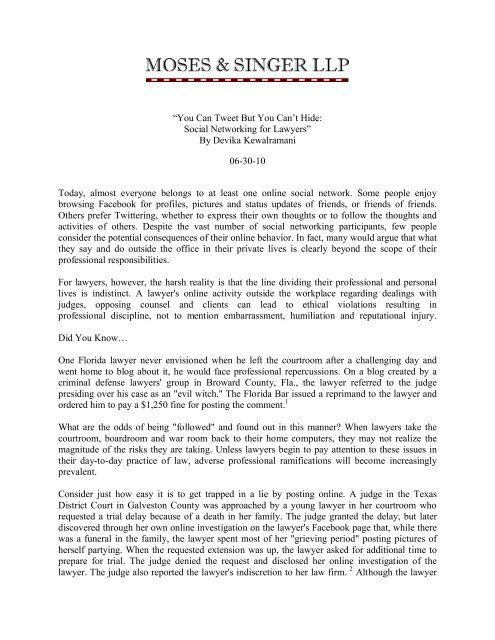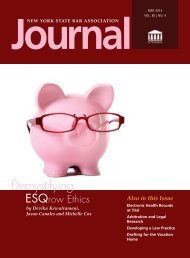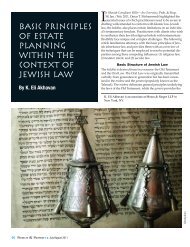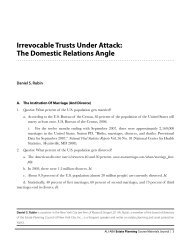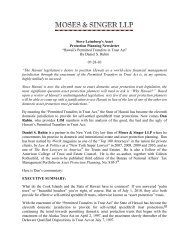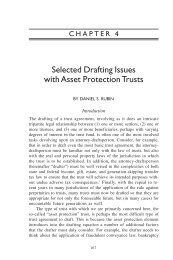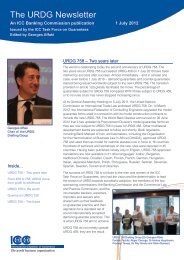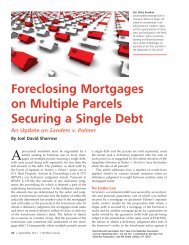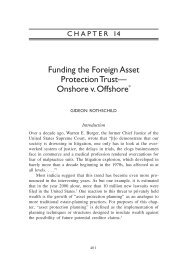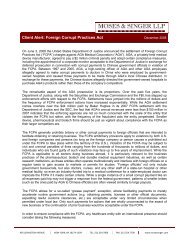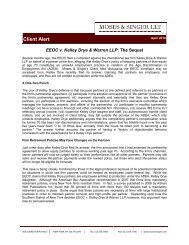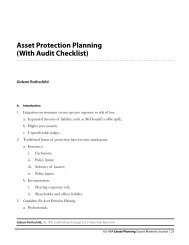âYou Can Tweet But You Can't Hide: Social Networking for Lawyers ...
âYou Can Tweet But You Can't Hide: Social Networking for Lawyers ...
âYou Can Tweet But You Can't Hide: Social Networking for Lawyers ...
Create successful ePaper yourself
Turn your PDF publications into a flip-book with our unique Google optimized e-Paper software.
was never <strong>for</strong>mally sanctioned by the Texas State Bar, her employment was terminated soonafter the incident.Bar Ethics Committees ReactState bar ethics committees around the country are beginning to take notice of the ethicalimplications of judges and lawyers engaging in online social networking. In January 2009, theNew York State Advisory Committee on Judicial Ethics issued an opinion, advising judges toexercise appropriate discretion in using social networking and to "stay abreast of features or anysuch service as new developments may impact his or her duties under the Rules [Rules of theChief Administrator of the Courts Governing Judicial Conduct]." 3 In April 2009, a judge inNorth Carolina was reprimanded <strong>for</strong> communicating ex-parte with a lawyer via Facebookregarding a pending trial in which the lawyer was representing one of the parties. 4 In November2009, the Florida Judicial Ethics Advisory Committee issued a <strong>for</strong>mal opinion advising judgesagainst "friending" or communicating with lawyers via social networking if they appear be<strong>for</strong>ethe judges in court. 5 The committee noted that allowing such activity would produce a publicrecord suggesting that certain lawyers, by virtue of being "friends" with judges online, wieldinfluence over them, thereby creating a presumption of impropriety.While the current focus of bar ethics committees appears to be on judicial conduct, similar ethicsor advisory opinions might be on the way <strong>for</strong> lawyers. This could be because the bench and thebar are closely related and judges and lawyers are generally held to comparable ethical standards.Note, the Florida Bar Examiners are considering conducting an investigation of each barapplicant on social networking Web sites as part of their evaluation of bar admission applicants. 6By including investigation of applicants' social networking activities in the bar admissionprocess, the Florida Bar Examiners will make it difficult <strong>for</strong> applicants to sweep under the rugany improper online activities that would otherwise escape scrutiny by admissions authorities.Applicable Ethics RulesA review of the New York Rules of Professional Conduct (NY Rules) reveals that commentsabout judges could run afoul of at least two rules: Rules 8.2(a) and 8.4(h). Rule 8.2(a) prohibits alawyer from making "a false statement of fact concerning the qualifications, conduct or integrityof a judge." Rule 8.4(h) operates as a "catch all" provision, prohibiting lawyers from "engag[ing]in any other conduct that adversely reflects on the lawyer's fitness as a lawyer." While manylawyers might think that blowing off steam is hardly conduct that "adversely reflects on thelawyer's fitness," in reality, that is exactly the type of behavior that the ethics rules prohibit. It ishighly unlikely that a lawyer would have thought it was proper to call a judge an "evil witch" inher courtroom. Why then did the lawyer think nothing of going home and creating a lastingrecord of the comment <strong>for</strong> the world to see?In connection with communications with judges, it goes without saying that lawyers areprohibited from engaging in conduct involving dishonesty, fraud, deceit or misrepresentation.Rule 8.4(c). Engaging in such conduct could indicate a lack of judgment which in turn reflectsadversely on the fitness to practice law. Rule 8.4(h). In addition, in New York, there is a specificstatute which deals with penalties <strong>for</strong> "deceit upon the court." New York Judiciary Law, §487.
Additionally, law students and out-of state lawyers seeking admission to the New York Barshould remember that Rule 8.1(a), which governs admission to the bar, provides that a lawyer issubject to discipline if, in connection with an application to the bar, he or she has made or failedto correct a false statement of material fact or has failed to disclose a material fact requested inconnection with a lawful demand <strong>for</strong> in<strong>for</strong>mation from an admissions authority.Best PracticesOnline social networks have become essential career building tools. Blogging, <strong>Tweet</strong>ing andFacebooking are everyday activities, especially <strong>for</strong> younger lawyers. So, how can lawyersproperly meet their ethical obligations while participating in various online activities?The best way <strong>for</strong> lawyers to avoid any adverse exposure from online activity is to adopt somegood old-fashioned common sense:· Be careful, what you "say" online "stays" online: even if you delete a post or comment,chances are it is stored somewhere.· Educate yourself about the Web sites you use and the privacy settings you choose: try to limitthe reach of your online conversations.· Think be<strong>for</strong>e you post, toast or roast: if you would not brag about yourself or tell a person tohis face what you think about him, don't do it online.· Avoid unintended audiences who can produce unexpected consequences: social networkingoften encompasses people you never intended to meet, some of whom can create unpleasantoutcomes if you are unwary.· Don't let your voice be distorted: you may think you are saying one thing but the personreading your blog or comment may interpret it differently.· Use your judgment: in certain situations, instead of posting a blog or comment that all your"friends" will see, consider calling a friend or, saying nothing at all.<strong>Social</strong> <strong>Networking</strong> 101Four of the most popular online social networksWhat ItIsTwitter Facebook MySpace LinkedInTwitter enables users Facebook allows each Similar to Facebook, LinkedIn is ato exchange news user to set up their own MySpace is premised professional socialand opinions. account to create a on the creation of user network that allowsMembers join and personal profile and a profile pages, registered users tolocate other network of friends with allowing users to maintain a list ofmembers they are whom to share share in<strong>for</strong>mation on a business peopleinterested in in<strong>for</strong>mation, pictures and more in<strong>for</strong>mal basis (referred to asinteracting with. interests.than Facebook. “Connections”) theyknow and trust.
How ItWorksSecuritySettingsUsers type in shortmessages or statusupdates that can beread by people (your“followers”)following them, asdoes anyone elsewho comes acrossthem in a search.A Twitter profile ispublic by default. Ifa user is hesitant tohave strangers readhis updates, he canlimit it to approvedfollowers and keephis updates out ofreach.Attached to each user’sprofile is a “wall” onwhich the user’s“friends” can postmessages, pictures,videos and/or links tointernet sites. A “friend”is someone who views auser’s profile andcommunicates with theuser via Facebook. Tobecome someone’sfriend, find their name inthe Facebook databaseand send a requestthrough Facebook to theuser’s e-mail address.Upon receiving therequest, the user caneither accept or deny it.If accepted, the new“friend” can view detailsabout the user, dependingon the user’s privacypreferences.Facebook af<strong>for</strong>ds usersbroad control over thepublic availability of thein<strong>for</strong>mation published ontheir profiles. A user withintermediate securitysettings may block hispictures posted onFacebook from beingviewed by anyone otherthan his “friends” butmight allow all users toview his walls orprofiles. A user opting<strong>for</strong> strict security settingscan “hide” his profile onFacebook to precludeother users from findinghis name in the Facebookdatabase when trying tosend a “friend” request.Profile in<strong>for</strong>mationincludes “About Me,”“Who I’d Like toMeet,” “Interests” and“Details.” Under“Details,” users canpost their education,employment history,etc. Profiles alsocontain a blog withstandard fields <strong>for</strong>content and media.MySpace alsosupports uploadingimages and videos.Like Facebook,MySpace offersdifferent levels ofprivacy to usersdepending on how auser sets his privacysettings. By default,MySpace pages arepublic and can befound and accessed bya Google search of aperson’s name.Users can invite anyoneto become a“Connection.” Contactnetworks are built up ofdirect connections andconnections of theirconnections. LinkedInallows users to researchcompanies where theyare interested inworking. “LinkedInAnswers” allows usersto ask questions <strong>for</strong> thecommunity to answer.“LinkedIn Groups”allows users to establishnew businessrelationships by joiningalumni, industry, etc.LinkedIn allows users toreview and edit personalin<strong>for</strong>mation through auser’s personal profilepage. Users can choosewhat in<strong>for</strong>mation tomake available to searchengines. However,certain LinkedInservices require it tomake a user’sin<strong>for</strong>mation available tothird parties. Users canchange their settings tocontrol visibility andaccessibility of theirprofiles.Devika Kewalramani is a partner and Co-Chair of Moses & Singer's Legal Ethics & Law FirmPractice Group. Valeria M. Castanaro, an associate at the firm, assisted with the preparationof this article.
Endnotes:1 Fla. Bar v. Conway, 996 So.2d 213 (Fla. 2008); John Schwartz, "A Legal Battle: Online Attitude vs. Rules of Bar,"New York Times (Sept. 13, 2009).2 John Schwartz, "A Legal Battle: Online Attitude vs. Rules of Bar," New York Times (Sept. 13, 2009).3 New York State Advisory Committee on Judicial Ethics, Formal Opinion No. 08-176 (Jan. 29, 2009).4 In re Terry, N.C. Judicial Stds. Comm., Inq. No. 08-234 (April 1, 2009).5 Fla. Judicial Ethics Advisory Committee, Formal Opinion No. 2009-20 (Nov. 17, 2009).6 Jan Pudlow, "On Facebook? FBBE May Be Planning a Visit," The Florida Bar News (Sept. 1, 2009) available athttp://www.floridabar.org/DIVCOM/JN/JNNews01.nsf/8c9f13012b96736985256aa900624829/d288355844fc8c728525761900652232?OpenDocument.Devika KewalramaniNew York, N.Y.Reprinted with permission from the “June 30, 2010” edition of the “New York Law Journal”© 2010 ALMMedia Properties, LLC. All rights reserved. Further duplication without permission is prohibited. Forin<strong>for</strong>mation, contact 877-257-3382, reprints@alm.com or visit www.almreprints.com.
DisclaimerViewing this document or contacting Moses & Singer LLP does not create an attorneyclientrelationship.This document is intended as a general comment on certain developments in the law. Itdoes not contain a complete legal analysis or constitute an opinion of Moses & Singer LLPor any member of the firm on the legal issues herein described. This document containsin<strong>for</strong>mation that may be modified or rendered incorrect by future legislative or judicialdevelopments. It is recommended that readers not rely on this general guide in structuringor analyzing individual transactions or matters but that professional advice be sought inconnection with any such transaction or matter.Attorney AdvertisingIt is possible that under the laws, rules or regulations of certain jurisdictions, this may beconstrued as an advertisement or solicitation.Copyright © 2010 Moses & Singer LLPAll Rights Reserved


